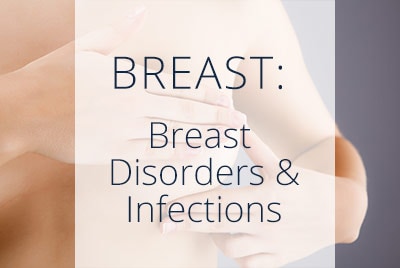What are Breast Infections and Disorders?
 Breasts are complex organs made up of fat, fibrous tissue, and tiny glands that produce milk. Like your uterus and other reproductive organs, your breasts change in response to the hormones estrogen and progesterone. This is why you may notice changes in size and sensitivity during different times of your menstrual cycle, pregnancy, breastfeeding, and menopause.
Breasts are complex organs made up of fat, fibrous tissue, and tiny glands that produce milk. Like your uterus and other reproductive organs, your breasts change in response to the hormones estrogen and progesterone. This is why you may notice changes in size and sensitivity during different times of your menstrual cycle, pregnancy, breastfeeding, and menopause.
If you discover breast lumps or bumps while you are conducting regular self-breast exams at home, or if your doctor finds an irregularity during a physical examination or screening, you might fear the worst, such as breast cancer. However, not all breast problems are an indication of breast cancer. Non-cancerous diseases of the breasts are common.
Below are some examples of benign breast disorders:
Fibrocystic Breast Changes
What doctors used to call “fibrocystic breast disease” is now better known as fibrocystic breast changes. The condition of fibrocystic breasts is less of a disease and more of a breast condition in which the breasts are composed of lumpy, glandular tissue. Fibrocystic breasts can be swollen and tender and feel lumpier than other women’s breasts.
While this condition isn’t harmful to your health, it can lead to breast pain, especially in the upper and outer regions, before the start of your period.
You can ease the discomfort with ice or a heating pad and an over-the-counter NSAID (a non-steroidal anti-inflammatory drug), such as ibuprofen. You may want to make sure that the bras you are wearing fit you well, to provide support to your breasts when they are feeling sensitive and swollen.
Fibroadenomas
Fibroadenomas are tumors comprised of a mix of glandular and fibrous tissue. They’re firm, smooth masses that might feel similar to a marble stuck in your breast. They’re most common in teenagers and women under 30. Although they’re typically not painful or harmful, some women may be recommended to have them surgically removed or biopsied.
Breast Cysts
Breast cysts are fluid-filled sac common in women aged 25-55. They usually disappear after menopause. Cysts, large or small, can feel hard to the touch or squishy like an over-ripe grape. Although cysts are not cancerous, they can sometimes be painful.
Painful cysts can be treated by draining the breast abscess through a fine needle aspiration or by surgical removal. After removal, your OB-GYN might recommend you take birth control pills to reduce the chance of cysts reappearing.
Mastitis (Breast Infection)
Mastitis is an infection of the breast tissue most commonly in breastfeeding women. It occurs when a woman’s milk duct becomes clogged and is unable to drain. A woman is most susceptible to mastitis within the first 12 weeks after giving birth, but it can happen during other times.
Symptoms of Mastitis
The infection causes swelling, pain, warmth, and redness in the breasts. In severe cases, you may develop flu-like symptoms and feel fatigued. If you’re experiencing these symptoms, it’s important that you seek treatment right away so that you can continue caring for your baby and yourself.
Mastitis Treatment
Mastitis can be treated by draining the breast milk, sometimes with a breast pump, and by taking antibiotics. Your doctor may recommend an application of a hot, wet washcloth for 10-15 minutes several times throughout the day. If you are breastfeeding, ask your doctor whether it is safe for you to continue during treatment.
Nipple Discharge
While it is quite normal for fluid discharge or milk to leak from your nipples when your pregnant or breastfeeding, this will decrease and eventually stop after you have weaned your baby.
Unexpected nipple discharge may be milky, clear, yellow, green, brown or bloody, thick and sticky or thin and watery, depending on the cause.
Nipple discharge can have a number of benign causes, including intraductal papilloma, mammary duct ectasia, abscesses, breast infection, excessive breast stimulation, fibrocystic breasts, galactorrhea, hormonal imbalance, injury or trauma to the breast, some medications, or prolactinoma, but also breast cancer.
What Do I Do if I Find a Lump in my Breast?
Finding a lump can be frightening, but it is not an uncommon experience. If you find a suspicious lump, please make an appointment with us. We can do a breast exam and order a mammogram if needed. A mammogram is a digital imaging test that helps us diagnose breast disorders.
We recommend that all women ages 40-75 have annual mammography to screen for abnormal growths. If we find something in the mammogram, we usually call you back for a second screening. This may include a more detailed mammogram, ultrasound, MRI, or biopsy. A biopsy involves removing a small sample of the lump for testing. It can be conducted with a narrow, hollow needle or with a surgical lumpectomy.
Once we get your results back, we can make a diagnosis and talk about your treatment options.
If you believe you are experiencing symptoms of, or suffering from Breast Infections and Disorders, or have questions about it, please see your doctor.
We also invite you to establish care with Dr. Aliabadi. Please click here to make an appointment or call us at (844) 863- 6700.

